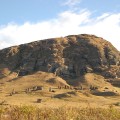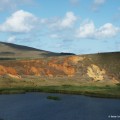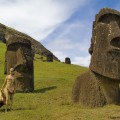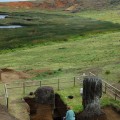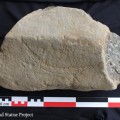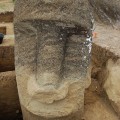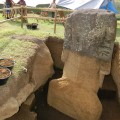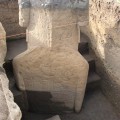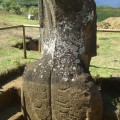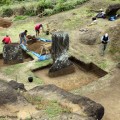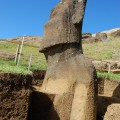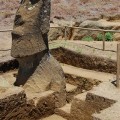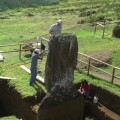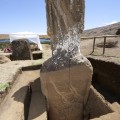Easter Island heads have great bodies!
Rano Raraku quarry (Figure 1), within which 95% of the over 1,000 Easter Island stone statues was carved, is a massive crater of consolidated volcanic ash surrounding an interior, reed-filled lake (Figure 2). About half of the total number of statues recorded to date is still within the quarry zone.
Some 150 statues stand upright on the interior and exterior slopes of Rano Raraku. They are buried to varying depths and appear often as heads only. While weathered and worn by centuries of exposure to the elements, many of them are still very beautiful (Figure 3).
Rano Raraku was first reported to the outside world in 1868 by officers of HMS Topaze. The world was fascinated, and many sketches, essays, newspaper articles, and books were published describing the statues embedded in the slopes as “heads.” Over 90 excavations in Rano Raraku since that time exposed the torsos of many statues. Katherine and William Scoresby Routledge of the Mana Expedition to Easter Island, 1914-15 published photos of their own digs illustrating the bodies of many statues. In 1954-55 Thor Heyerdahl and his Norwegian Archaeological Expedition to Easter Island excavated others, further documenting the existence of complete, but partially buried, statues.
Our EISP excavations recently exposed the torsos of two 7 m tall statues (Figure 4). Hundreds, perhaps thousands, of visitors to the island have been astonished to see that, indeed, Easter Island statues have bodies! More important, however, we discovered a great deal about the Rapa Nui techniques of ancient engineering:
- the dirt and detritus partially burying the statues was washed down from above and not deliberately placed there to bury, protect, or support the statues
- the statues were erected in place and stand on stone pavements.
- post holes were cut into bedrock to support upright tree trunks
- rope guides were cut into bedrock around the post holes
- posts, ropes, stones, and different types of stone tools were all used to carve and raise the statues upright
We also discovered that ceremonies were certainly associated with the statues. We found large quantities of red pigment, some of which may have been used to paint the statues. Finally, and perhaps most poignantly, we found in the pavement under one statue a single stone carved with a crescent symbol said to represent a canoe, or vaka (Figure 5). The backs of both statues are covered with petroglyphs, many of which are also vaka. A direct connection between the vaka symbol and the identity of the artist or group owning the statue is strongly suggested.
Want to know more? Read our excavation reports for Seasons I, II, III, IV and V.
 English
English  Español
Español 